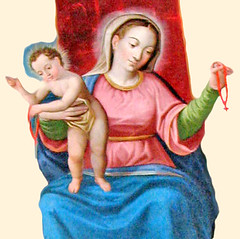Blessed Jordan of Saxony (Part One)
 As promised... The following is a presentation I delivered this week in Blackfriars and is about Blessed Jordan of Saxony, the Second Master General of the Order of Friars Preachers, who is a most attractive saint and one I grew quite fond of in my preparation for this talk!
As promised... The following is a presentation I delivered this week in Blackfriars and is about Blessed Jordan of Saxony, the Second Master General of the Order of Friars Preachers, who is a most attractive saint and one I grew quite fond of in my preparation for this talk!"It strikes me that every Friday we pray to Blessed Jordan as ‘patron of Dominican vocations’ and call him the ‘worthy successor of St Dominic’. I wondered why such epithets were given to him and thus I really wanted to find out more about him. In doing so, I encountered a man who still reaches out to me, a Dominican novice, across the centuries and whose personal charisma and holiness is still apparent and attractive as a path of an authentic Dominican spirituality.
Sources
The main biography of Bl Jordan is ‘St Dominic’s Successor’ by Marguerite Aron. Her work is often referred to by other writers and probably stands as the most complete account of his life.
But apart from this, we are fortunate to have surviving documents written by Bl Jordan himself. Indeed he is one of the few leaders of the 13th century to have left a personal as well as an official correspondence. Notable among his writings is his corpus of letters to Bl Diana d’Andalo, foundress of the Dominican convent of St Agnes in Bologna. Of the 56 surviving letters written by Bl Jordan, 37 were addressed to Bl Diana, 13 to her community of St Agnes, 4 to a Benedictine nun at Trier, and 1 to the friars’ community of St Jacques in Paris. There is also an ‘official’ letter to Stephen, Provincial of Lombardy. Only one of his encyclical letters (of May 1233) to the Order remains but his practice began a tradition which still persists and Masters General of the Order still write letters to the entire Dominican family.
These letters and the many travels of Bl Jordan throughout the Order (itself a practice undertaken by successive Masters General and enshrined in the Constitution) indicates his “outstanding example of concern for Dominican communion”. Jordan spent a great deal of time in this task and showed much patience and interest in building the bonds of love between the different branches of the Order, men and women. In his letters he shares his concerns and tasks with the sisters in Bologna and often asks for their prayers in support of his work. This dynamic, these “bonds of love” as he called them, still marks the relationship between the sisters and the friars.
In addition, Jordan also wrote the Libellus, which is an account of the life of St Dominic and the Origins of the Order dating from about 1233. Guy Bedouelle, OP describes this as “one of the gems of medieval hagiography” and he says of Jordan’s work: “I never cease to marvel at the keenness of penetration, the theological sense rooted in a knowledge of Scripture that shines through every sentence, the precision of details gathered from all those who created the Order with St Dominic.” Coming through in both the letters and the Libellus is Jordan’s affectionate nature and warmth, which is familiar but never sentimental. His friendship with Bl Diana and Henry of Cologne (who was clothed with him) rank among the most famous of Christian friendships.
Finally, we have the Vitae Fratrum which was compiled by Gerald of Frachet and approved by Bl Humbert of Romans in 1260, following an ordination in the General Chapter of 1256 that called for miracles, stories etc within the Order to be reported to the Master General. Thus it is a collection of anecdotes, charming recollections and tales by the early friars about the origins of the Order. Within its pages we find the only description of St Dominic’s appearance (given by Sr Cecilia) and also legends and tales with relation to St Dominic and Bl Jordan, among other fascinating stories. Bede Jarrett OP feels that the editing of the work could have been better but he recognizes that “to the historian [the Vitae Fratrum] is invaluable” and he refers to the story within about Bl Jordan of Saxony as “its chiefest charm”.
As such, it is from these sources that I have tried to glean and distill a life and spirituality of Bl Jordan."
To be continued... Tomorrow: a Biographical sketch.







0 Comments:
Post a Comment
<< Home